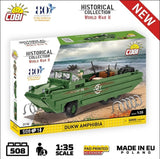The DUKW (colloquially pronounced "Duck") was a six-wheel-drive amphibious truck utilised extensively by the Allies during World War II. Designed in 1942 by the Sparkman & Stephens firm in partnership with General Motors, it was primarily used for transporting goods and troops over both land and water.
The DUKW was engineered from the GMC CCKW truck, a widely-used vehicle in the U.S. military. It featured a steel hull, which made it buoyant, and a propeller driven by the vehicle's engine, allowing it to travel at speeds up to 5 knots (9.3 km/h) in water. On land, the DUKW could reach speeds of up to 50 mph (80 km/h). Its cargo capacity was impressive, capable of carrying up to 5,000 pounds (2,300 kg) of supplies or 25 fully equipped troops.
A key innovation was its central tire inflation system, enabling the driver to adjust tire pressure from within the cabin, optimising traction across various terrains. This made it exceptionally versatile, capable of handling beaches, riverbanks, and rough roads.
The DUKW's operational impact was profound during key amphibious assaults, such as the D-Day landings in Normandy and the Pacific Island campaigns. Its ability to seamlessly transition between water and land operations significantly enhanced logistical efficiency, contributing to the Allied victory. By the end of the war, over 21,000 DUKWs had been produced, cementing their place in military history.
 Skip to content
Skip to content



















